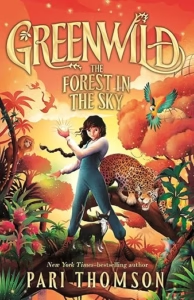Greenwild: The Forest in the Sky (Greenwild #3)
Pari Thomson
Farrar, Straus, & Giroux
Published June 3, 2025
Amazon | Bookshop | Goodreads
About Greenwild: The Forest in the Sky
The Secret Garden meets A Wrinkle in Time in the spellbinding final book of the New York Times-bestselling Greenwild series.
Daisy and her friends may have defeated the Grim Reapers in Iffenwild, but it’s clear that the battle for the Greenwild is only just beginning…
With the support of the Iffenwilders and their mighty water magic, Daisy and her friends are finally setting off to rescue the Botanists held prisoner in the heart of the Amazon rainforest – including Daisy’s ma and the Prof’s grandfather.
But when an unexpected attack sends the rescue mission spinning off course, Daisy, Indigo, and the Prof find themselves in the Amazon alone – where they must draw on every ounce of their courage, magic, and ingenuity to survive. This is a battle that can’t be won single-handedly, and Daisy will need the support of her new friend Max, a strange Grayside girl called Fen, and the massed might of the Amazerians, guardians of the biggest and most magical pocket in the Greenwild – if she is to take on the Reapers once and for all.
Readers will not want to miss this thrilling conclusion to the Greenwild series.
My Review
I’ve been eagerly following this series from the very beginning. Reading the last book in a series is always bittersweet, because it means the characters’ journeys end, but it also means we know how the story plays out. I saved reading this one for the perfect moment in my recovery, when I’d be able to read far past bedtime and get completely lost in the pages.
The story follows two groups of characters. First, there’s Daisy, Indigo, and Prof, who head off to the Amazon to find the Greenwild pocket of Amazeria. Then, there’s Max and Acorn, who try to follow them and end up on a separate adventure. The chapters alternate between Daisy and Max’s points of view. I think the chapters from Max’s perspective had a sweet tenderness to them as he discovered things about his family members that he never knew and had the space to grow into his magic and his identity.
I also liked the way that magic is used through the course of the book. Daisy can talk to plants and do some plant magic. Indigo can talk to animals. Max has water magic. These abilities come in handy in sometimes unexpected ways. I liked that all of them had value and limits, so no one ability was outsized.
The ending of the book unfolds so quickly. (Or maybe I just read it quickly because I was so eager??) There were a couple of moments in which the identity of some characters is revealed, and I found myself wishing we’d lingered in that realization a little bit more. It was totally okay as is. I don’t think any of those reveals were shortchanged. Possibly, I just wanted longer to revel in the ending of the book and to spend a little more time in this rich story world.
I think readers who enjoy rich, magical fantasy stories will really enjoy getting lost in this botanical series. The story explores family relationships and found family as well as finding courage and bravery within oneself. It’s got strong positive messages and a powerful, hopeful message.
Content Notes
Recommended for Ages 8 to 12.
Profanity/Crude Language Content
None.
Romance/Sexual Content
Vague references to a possible crush between characters.
Spiritual Content
Some characters can do magic. There’s green magic, or magic involving plants and blue magic, or magic involving water.
Violent Content
Situations of peril. Brief battles between Reapers and Botanists. In one scene, Caimans chase the characters. One bites a character (happens off-scene). Reference to a quarrel that ends in murder (happens off-scene). Someone offers themselves to an enemy in place of another character. In one scene, a falling tree lands on a cat.
Drug Content
Plants cause dreams, remedy illnesses, and cause confusion, depending on the type and use.
Note: This post contains affiliate links, which do not cost you anything to use but help support this blog. I received a free copy of this book in exchange for my honest review. All opinions are my own.
